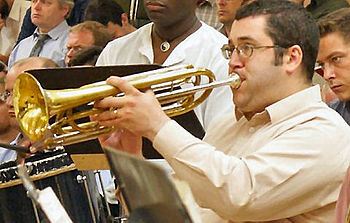People literally use TOO many muscles when they play. They use muscles that actually work against playing as well as muscles that help playing. They pull with the cheeks out and pull with the corners in; they pull the chin down and try to make the lips compress. These are OPPOSITE actions and they just tire us out. Think about what the muscles do and then how they affect playing. When we learn where the extra tension is then we are automatically stronger.
 |
| Duncan Wilson playing Rotary Bass Trumpet in C with the BBC Symphony Orchestra (Photo credit: Wikipedia) |
Isometrics are good for adding muscle strength but NOT good WHEN we are playing. As far as isometrics go all you need is a unsharpened pencil. It costs 5 cents and gives you all of the workout you will ever need. Most people use the muscles UNDER the lower lip for compression and the pencil isolates that better. The pencil exercise should be done with the teeth CLOSED. That makes the lower lip do the work. When the teeth are apart the jaw moves and the pencil is partly supported by the jaw and neck. Working the neck is a BIG concern for many players as some of them have real issues with the throat closing.
The corners of the Buzz or vibration is INSIDE the mouthpiece. The actual mouth corners are isolated from the embouchure by the mouthpiece rim and pressure. Poor choice of words from many years ago. There are many embouchures and the corners play a significant part in only ONE of them. You have to realize that people have done themselves a disservice by blending and mixing embouchure ideas together that don't fit.
Sand is OK. Water is OK. Water and sand together make MUD. That is what we do when we keep assuming that ANY embouchure idea or exercise will work with another one. We muddy up our abilities.
What is the BEST embouchure? None of them. Maynard Ferguson used some pucker. Andrea Tofanelli rolls his lips in and uses a forward jaw. Arturo Sandoval buzzes. Walt Johnson has his top lip overlap his lower lip. Bob Odneal uses compression made by bunching his chin. Nick Drozdoff uses his tongue against his lip as part of the embouchure.
6 high note players and 6 completely DIFFERENT embouchures. Yet for some reason people think there is A high note embouchure. (NOT mixing several embouchures together by accident IS the high note embouchure.) Some of those NEED mouthpiece pressure to work. When you over lap the lips pressure IS the way they make compression. Now that is different. Some embouchures need tongue arch to induce a slight curl (when the tongue moves it moves the jaw and that realigns the lips and causes curl.) But in some like the Stevens; tongue arch is useless because the lips are already curled (the tongue can't move enough to add to the curl.)
See those 6 embouchures I have mentioned are NOT all of them. Plus there are variations on each. There are even some others I haven't mentioned yet. Bill Houghton - Principal Trumpet - BBC Symphony Orchestra plays with ONE lip against the tongue. The tongue takes the place of the bottom lip. (That was first written about in the ITG Journal Sept 1995.)
See there are many variations that work as long as we don't mix something from embouchure A with something from embouchure B and something from embouchure C. Mixing these elements often adds excess and throws off the balance that we need between lip aperture, firmness, relaxation, air support.... When this balance is upset then our progress halts and sometimes reverses.
Putting Ford parts on a Chevy doesn't work. That is why MOST embouchure experiments fail. The WAY we use some muscles and the WAY we use our jaw and the WAY we set our lips makes each of us a Chevy, or Ford, or Cad, or&& This makes actions that are VITAL to some setups completely worthless for others. See the old habits and over built muscles have to be overcome BEFORE the experiments have a chance of success.
ALWAYS Useful for playing:
Actual lips themselves the Orbicularis oris ---------- close mouth, purses lips.
The muscle in middle of chin the Mentalis ---------- protrude lower lip and makes compression.
The muscle that goes from under corners of lower lip the Depressor anguli oris ---------- frowning and makes compression.
OFTEN Harmful for playing:
The muscle of the Upper cheek the Zygomaticus major/ minor ---------- smiling and thins the lips.
The muscle that goes from the cheek bone and lips the Buccinator ---------- compresses cheek and thins the lips.
The muscle that goes from the ear to mouth corners the Risorius ---------- smiling and thins the lips.
The muscle that goes from the lip to nose the Levator labii superioris ---------- raises upper lip and parts the lips and pulls top lip above teeth gap
The muscle that goes from the jaw to mouth the Depressor labii inferioris ---------- lowers lower lip and parts lips.
The muscle that goes from the neck muscle that goes from jaw to shoulder the Platysma ---------- depresses mandible, lowers the lip and parts the lips.
The largest cheek muscle the Masseter ---------- closes jaw and chokes the air flow.
The muscle that goes from the top of cheek towards back of head the Temporalis ---------- closes jaw (elevate mandible) and chokes air flow.
Many players use ALL of these muscles but when you actually look at what they do then you see they hinder playing. So my best advice to you is that you check and see what elements are supposed to be present in the embouchure that you play and to not add ideas from other systems to it.
http://www.BbTrumpet.com Article Source: EzineArticles |


No comments:
Post a Comment